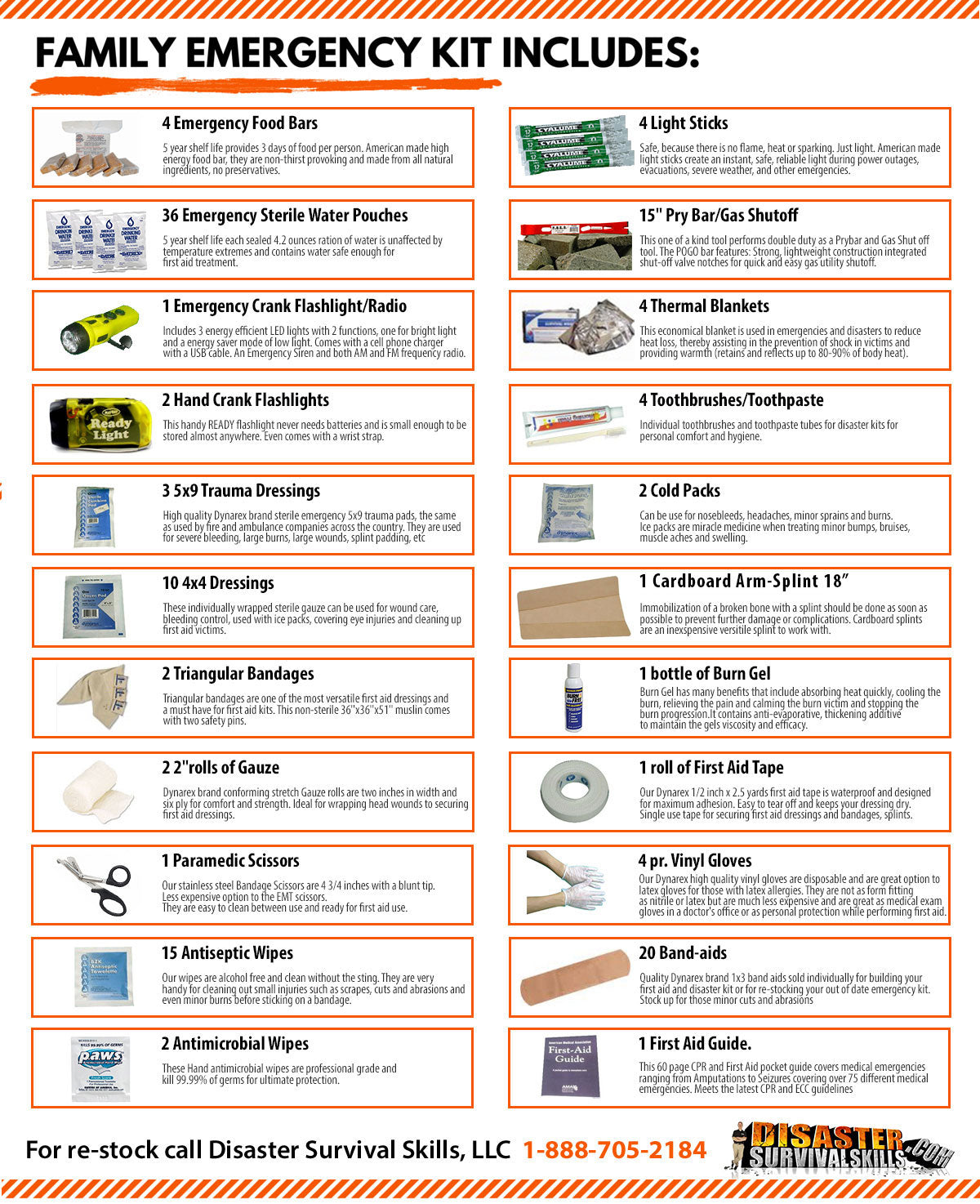How to make a disaster survival kit for most emergencies requires planning and forethought. I am going to cover the basics and why they are important, then of course you should add your own personal preparedness needs for medicine, extra eyeglasses, etc. to complete your Disaster Survival Kit.

First Aid should be your first consideration for your Disaster Survival Kit needs. Band-aids of course should be included, but shouldn’t be the mainstay of the kit. Consider trauma dressings that are 5 x 9 in size and can handle severe bleeding or wound care. Don’t make the mistake of believing sanitary pads are a good replacement for a trauma dressing. Female hygiene pads are designed not to aid in clotting of blood, just the opposite of what a trauma dressing is designed to do. Sanitary napkins will absorb and draw blood away from the wound rather than control the bleeding.
For burns there is no better product than Burn Free Burn Gel Dressings. This product addresses all the concerns with burns. It handles the infection issue with its built in antimicrobial properties. Its dressing not only stops burn progression and pain immediately and prevents hypothermia it is safe to use on everyone. Last but not least, the dressing will not stick to the burn and because the burn gel is water soluble there is no need to debride the burn once at the hospital.
Thermal Blanket could be considered part of the first aid because they are great for managing a shock victim. Small enough to fit into your back pocket, but opens up to 56 x 84 inches in size. The main advantage along with being water proof and lightweight is they do not absorb heat from the patient but instead they reflect the heat back to patient keeping the victim from going into hypothermia shock also. They are very inexpensive so get enough for each family member.
Long Term Water Storage is your next consideration. How do you store water long term in a kit that is safe to drink years later? The solution is Sterile Water Pouches. These pouches are usually 4.2 ounces each and are purified and then sterilized and packaged in double foil pouches for long term safe storage. So why such a small amount of water in each pouch? Why don’t they pack 8 ounces or more in each one? Mainly because they were designed for the military and survival. So when a pilot goes down he/she needs a lightweight water supply to keep them hydrated. It is also believed that the body only absorbs about 4 ounces of water in an hour for hydration purposes, so anything more than that would only be a waste. Which is important to know for your own survival when rationing a limited amount of water for yourself and family.
Long Term Food Storage is also a tricky one. Who wants to be rotating food and water from their kit every few months. And cans are just too heavy. You want a food that can last at least five years and stores well in the heat especially if considering the disaster survival kit in the car. The Food Bar meets all these needs by being a high calorie food that is also non-thirst provoking. They come in 1200, 2400 and 3600 calories and from several manufacturers as does the water pouches.
Flashlights come in different forms now with LED lights being a huge advantage by providing great light while using very little energy and the bulbs lasts for years. But you still have to rotate and replace batteries, unless you go with a dynamo crank flashlight which some also include radios. A Dynamo flashlight is a great option to throwing out batteries every few months. If you opt for battery style remember when batteries are stored in the flashlight they degrade quickly but give you the advantage of not having to look for batteries in the dark.
Light sticks are another great addition to the disaster survival kit because they have a shelf life of 5 years and provide 360 degrees of light for 12 hours. Although not bright focused light like the flashlight, they are visible for miles. These should always be used in place of candles to reduce the risk of fires following your disaster, especially an earthquake with dozens of aftershocks rocking candles onto the floor. Light sticks are safe around gas leaks (no sparks) and a perfect safe solution for kids.
These are just some of the very affordable essentials that you can put into your kit and don’t forget to make it your own by adding items for your own personal needs.

